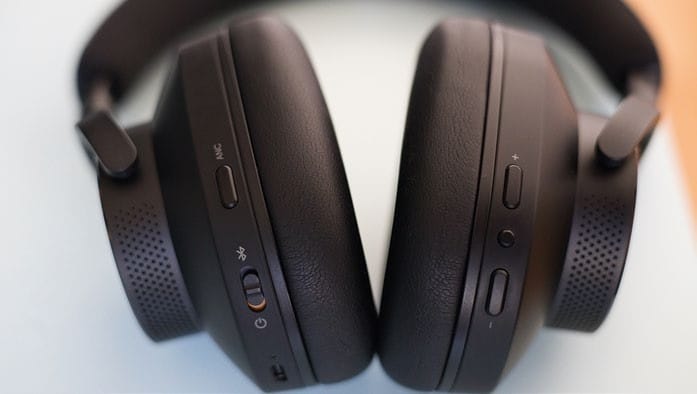Cambridge Audio Melomania P100 Review
Thanks to Class A/B amplification and outstanding noise cancellation, the new Cambridge Audio Melomania P100 promises to be an over-ear headphone that will make the competition nervous. But how much should the competition really fear it?

In July 2024, Cambridge Audio surprised us by announcing the upcoming release of an ANC over-ear headphone. As headphone enthusiasts, we eagerly awaited the Melomania P100. By the end of August, the Cambridge headphones arrived safely at our test lab in Leipzig.
What’s in the box
The Melomania P100 comes with a hard case, offering solid protection for the headphones. Inside the case, we find a USB-C-to-3.5mm cable and a USB-C-to-USB-C cable. Cambridge has followed the trend of most headphone manufacturers and omitted the headphone jack. There’s only a USB-C port. Both cables are fabric-covered, which feels pleasant and high-quality.
The case is slightly larger than those of competitors, but it features the embossed Cambridge Audio logo—just like on the headphone ear cups. These small, fine details are something we really appreciate.
Design & Comfort
The design of the Melomania P100 is what we’ve come to expect from Cambridge: top-notch. The British company knows how to present timeless understatement in its best form. The headphones look modern without being flashy, and their simple elegance is impressive. The ear cushions, with their 6×4 cm inner diameter, are large enough to comfortably fit over the ears of our tester.
As expected for headphones in this price range, the ear cushions are replaceable. The fit on the head is rather snug—at least for our tester with an XL hat size. So, you can nod your head while listening to music or even go for a light jog with the Melomania P100. It works just fine. However, it should be noted that these are not sports headphones. One downside is the headband, which is quite hard and becomes noticeable on the top of the head after some time. A bit more padding would have been appreciated.

Controls
We really appreciate that the headphones are operated via physical buttons—no swiping or tapping on the outside of the headphones. The controls are classic. On the right, larger buttons control volume, while a smaller button in between pauses playback. You can also answer calls with this button.
On the left earcup, there’s a slider for powering on/off. Sliding it further activates pairing mode. Above the power switch is the ANC button.
This allows us to switch through different ambient sound modes: Active Noise Cancelling (ANC), Transparent (to hear surroundings), and Off (all modes disabled).
Cambridge has also provided an app for the headphones. Here, you can also select ANC modes and even adjust its strength. If you want to tailor the sound to your preferences, you’ll enjoy the well-designed EQ. It allows for custom settings or the use of presets like Blues, Rock, Voice, etc. Other functions, such as Game Mode (to minimize latency) or changing the headphone voice prompt, can also be controlled via the app. The app also allows you to enable or disable wear detection, which pauses playback when you remove the headphones.
Wired Operation
Many Bluetooth headphones sound different when used as wired, passive headphones compared to wireless mode. Typically, the wired sound is more expressive and dynamic. However, this isn’t the case with the Cambridge Melomania P100, as they cannot be used passively. Even when wired, they need to be powered on. They sound almost the same as over Bluetooth, although they are slightly quieter in wired mode.
Since these over-ears remain active even when wired, they consume battery power. If the battery is dead, you can’t simply use them as passive headphones. This is something some competitors’ products allow. However, it’s unlikely you’ll ever run into this scenario, as the battery lasts up to 60 hours with ANC on, and up to 100 hours without ANC. That’s incredible. Plus, with just 5 minutes of charging, you get 4 hours of playback. So, battery issues should be rare.
Technical Specifications
One interesting aspect of the Cambridge Audio Melomania P100 is the amplifier. Usually, active headphones use Class-D amplifiers. But this over-ear uses a Class AB amplifier, the same type found in Cambridge’s CX series. This ensures that their characteristic sound is carried over to the headphones. And it works—more on that later. The Melomania P100 features 40mm drivers made from a triple-layer composite material to deliver the full sound of the Class AB amplifier. The headphones use Bluetooth 5.3 and support profiles like A2DP, AVRCP, HSP, and HFP, as well as codecs such as aptX Lossless, aptX Adaptive, AAC, and SBC.
Inside, there’s a powerful Qualcomm QCC3084 processor with a three-core architecture and a configurable 32-bit Kalimba audio DSP core running at up to 240 MHz. An Analog Devices ADAU1787 codec with FastDSP ensures efficient audio processing.

Active Noise Cancellation
Almost all Bluetooth headphones now come with ANC. Usually, it works reasonably well, but they can’t compete with ANC flagships from Sony, Sonos, Bose, or Apple. We expected the same from the Melomania P100—decent ANC, but not on par with the industry leaders. However, we were pleasantly surprised. The ANC on the Cambridge Melomania P100 outperforms the Sony WH-1000XM5, Sonos Ace, and Apple AirPods Max.
That’s truly impressive! The background noise from a busy road nearby is practically inaudible under the Cambridge over-ears, with only a faint hum when a particularly loud vehicle passes. On the Sonos or Sony headphones, the road is still slightly audible. Even the vacuum cleaner is less annoying under the P100 than with the competition. That’s really a surprise.
One thing to note is the noticeable background hiss in ANC mode. It’s louder than with Sony or Sonos, but it disappears when music plays. Also, the over-ears are hardly affected by wind noise in ANC mode. We can occasionally hear a bit of wind rustling through the ANC mics, but it’s quiet and barely distracting. Overall, very well done!
Sound Impressions
The Cambridge Audio Melomania P100 offers a wonderfully balanced frequency response that makes the sound feel natural. They don’t color the sound at all. We can listen deeply into the music or enjoy audiobooks with all their sound richness. Their soundstage is excellent, though slightly less expansive than the Sonos Ace. However, that’s a matter of taste, not a critique.
Since we can adjust the sound with the EQ, we’re extremely satisfied with these new over-ear headphones from Cambridge. Fans of the excellent sound of the Technics EAHA800 will be more than pleased with the Melomania P100. If you’re curious, check them out at the 2024 Mitteldeutsche HiFi-Tage (1st Floor, Room Zeitz), where you can test them with your favorite music.
Conclusion
The Cambridge Audio Melomania P100 impresses with excellent build quality, timeless design, high comfort, and great sound. Its active noise cancellation even surpasses that of flagship models from Sony, Sonos Ace, or Apple. Sound-wise, the P100 delivers a natural and balanced audio profile, which can be customized via the integrated equalizer. The impressive battery life of up to 100 hours without ANC and 60 hours with ANC makes it the ideal companion for long listening sessions.
Features
• Class A/B amplification technology
• Up to 100 hours battery life
• aptX Adaptive Audio, aptX Lossless
Advantages
- Outstanding active noise cancellation (ANC)
- Excellent sound quality
- Many app features
Disadvantages
- No passive wired operation possible
Tech Specs
General
Device class: Headphones
Price category: Mid-range
Manufacturer: Cambridge Audio
Model: Melomania P100
Dimensions (W/H/D): 25 × 20 × 6 cm
Weight: 330 g
Information: www.cambridgeaudio.com
Technical data (according to the manufacturer)
Operating mode: Active
Design: Closed, Over-ear
Frequency response: Not specified
Sensitivity (wired) or Codecs (Bluetooth headphones): aptX Lossless, aptX Adaptive, AAC, SBC
Connection to the headphones: Bluetooth 5.3
Battery:
- Runtime: 100 hours
- Charging time: <160 minutes
Ports: USB-C
Noise-cancelling: Yes
Earpads: Faux leather
Rating
Bass reproduction: 19.5/20 → 9.75/10
Midrange reproduction: 19.5/20 → 9.75/10
Treble reproduction: 19.5/20 → 9.75/10
Spatiality: 9.5/10 → 9.5/10
Playback quality (total): 68/70
Build quality and finish: 8/10
User-friendliness: 9/10
Adjustments: None
Interim result: 85 out of 90 points
Price/performance: Excellent (10/10)
Result: Reference class, 95%





